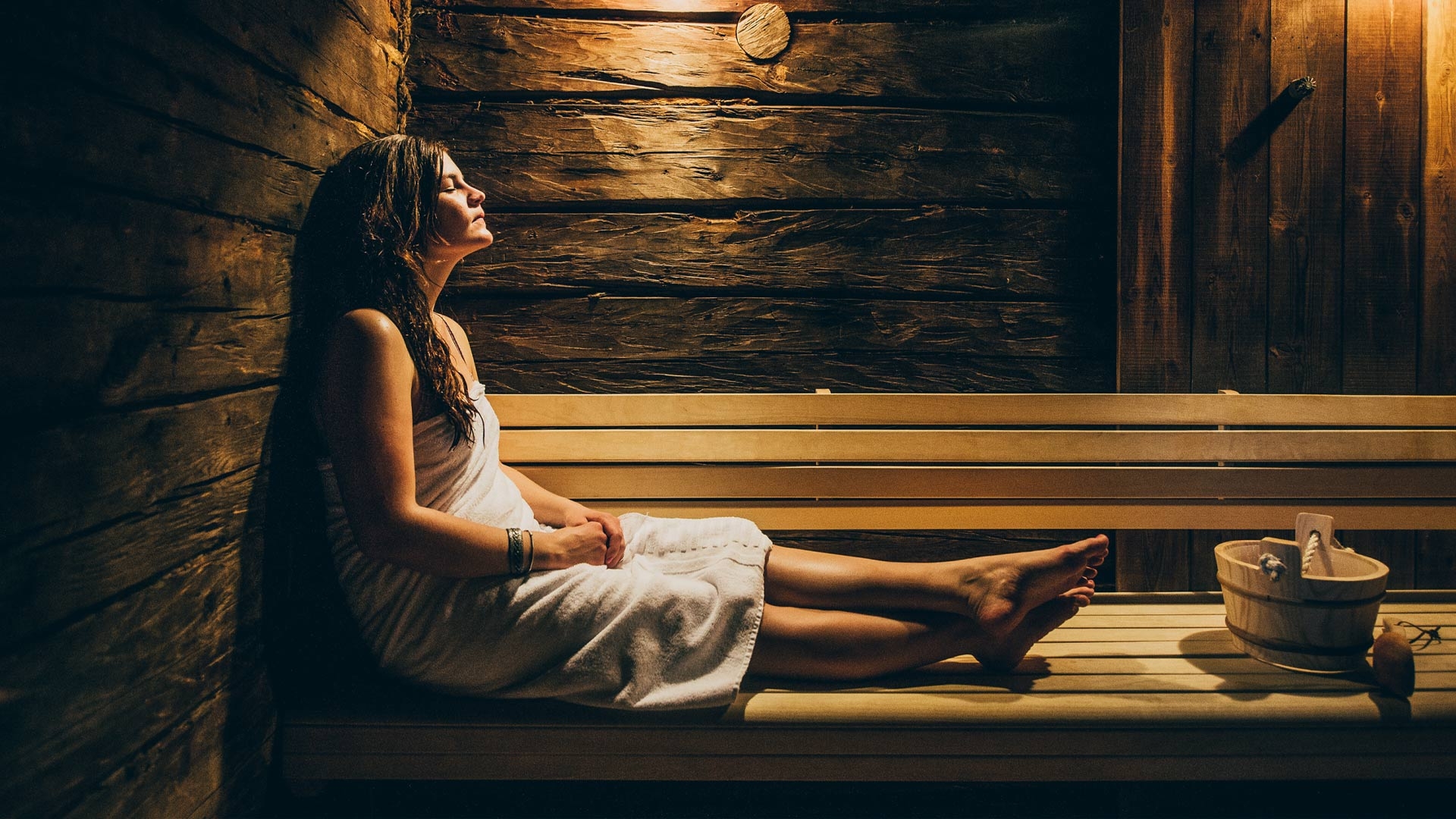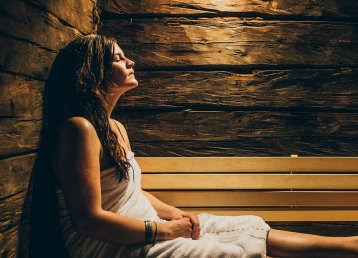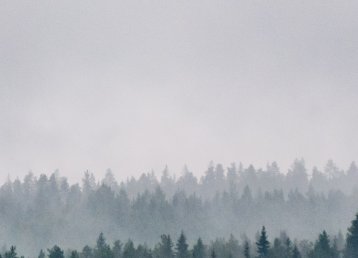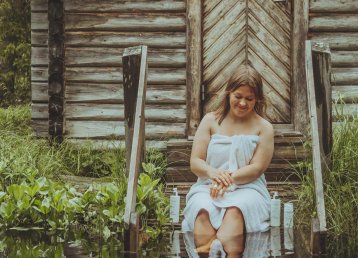Sand between my toes
I step out of the cold Bothnian Bay, surrounded by kilometre-long stretches of sand, the open sea and one of Sweden’s most remarkable campsite stories: Pite Havsbad. Spring has been mild, and summer has begun, but even so, the sea is not yet warmed by summer.
With sand between my toes, I dry myself and wonder what will be served for breakfast. Perhaps it is a sin to think about food as often as I do, but at least it is a pleasant thought. Far better than tax authorities, tyre changes and “the state the country is in”. I walk towards the breakfast room, past the spa-pier at Havsbadet. Last night I lay there in a jacuzzi, in the midnight light, feeling comfortable. Now I am on my way to blueberry smoothies, strong coffee, scrambled eggs and a day that looks damn promising. It also seems like I am on my own here at this early morning hour, just gone six on a Friday, as June has just begun. In 1944, Elof Söderberg from Jävre bought four hectares of sandy beach here on Piteholmen. Elof was an electrician and entrepreneur, and he had soon set up some cabins for rent and opened a kiosk to sell ice cream. Piteå was Sweden’s warmest town for three years in a row in the 1950s, and the place became known among the public as ‘the Northern Riviera’. People arrived en masse, and Elof’s success was a fact.
An industry for health
“We all want to feel good”, I think to myself as I dry off the cold water. Not only do we want to feel whole, healthy and perhaps a little beautiful – we want to be it too. The health trend is hardly a trend any longer, more part of our daily life. Even if travelling to find your own well-being is nothing new – the town Spa in Belgium became famous back in the 14th century for its springs, and we know both Greeks and Romans liked their thermal baths – it is the fastest-growing part of the hospitality industry. Between 2015 and 2017, the global health industry grew by almost 13 per cent. In other words: almost twice as fast as the general global economy. Within the health industry, travel accounted for a large part of this money and the increase. In 2017 health travel had a global turnover of $639 billion. The forecast was also that by 2022 it would increase to $920 billion if the continued trend of a 6.5 per cent annual increase had been allowed to continue. As it were, life got in the way. And we will all have to start again. But this is when it helps to take a refreshing bath and remind yourself about your wonderful life.
This year’s Hamlet question
“To bathe, or not to bathe” seems to be the new Hamlet question of middle age. The amount of ice-bathing people flooding social media feeds has increased of late and become something like an avalanche. As if it were a test of manhood. It may be the case that jumping into the cold is something of a challenge, but the fact is that ice-cold baths have long been considered really healthy. Nowadays, there is research confirming that ice baths make the body feel good. British athletes such as tennis player Andrew Murray, heptathlete Jessica Ennis-Hill, runners Paula Radcliffe and Mo Farah have all taken ice baths after a tough session to recover faster. Ice baths have an anti-inflammatory effect. Australia’s cricket manager says:
— They used to put beers on ice. Now the athletes end up in it.
Research has shown that if you want to build muscles, the anti-inflammatory effects of ice bathing might be counterproductive in a build-up phase of heavy weightlifting. To build muscles, you need that soreness, not ice baths. But the fact that it is good for you in so many ways has been known by Shinto priests and ordinary Northerners for centuries. First a sauna, then straight into the snow.
— Cold baths really are good for us, says Jeanett Pogulis, spa manager at Hotel Kust in Piteå, and continues:
— We have players from Piteå IF coming here to jump into our ‘hole in the ice’. They stay there for 20 minutes and say it’s a great way to get over a game, both physically and mentally.
Evil spirits
The spa area at Hotel Kust is on the eighth floor, overlooking the coastal town that looks so neat and orderly. Some fishers are out on the water, where the river meets the sea. Kust’s whole idea is a journey along the Pite River, from the mountains to the sea. This is the theme of the spa as well: that meeting between hot and cold, the ice of the mountain, the moss of the forest and the sand of the sea.
Jeanette has managed Kust’s spa for the last few years. She got her education in California, long before spa and well-being became a reason to travel the world. Kust not only has that hole in the ice but there are also three different kinds of sauna here. As soon as you start your spa treatment, there is a steam sauna in the area called ‘Clean’.
— There, as you’re being purified, you’re relieved of your evil spirits, says Jeanette and smiles, mainly that spirit which is known as stress.
It is not that easy to reset and leave your everyday worries in the changing room. Perhaps that is the great luxury of our time: just to be yourself for two hours. Sitting there in the steam room, while the face mask works its wonders, doing nothing but breathe. On my way through the spa treatment, I rub down with ice from the ice fountain. The Pite River is born from the glacier Sállajiegŋa. The cold ice hitting my body after ten minutes in a steam sauna brings me to life. After foot baths, hair treatments and an aroma sauna, it is time for the cold again, in that ‘hole in the ice’. I do not stay for 20 minutes, however, moving briskly along to the Finnish sauna. I sit in there, feeling great before taking on the steaming hot pool on the roof terrace. “I could stay here forever”, I think, “all that other stuff I can always do later”.
A perfect löyly
In sauna veritas, as the proverb of the Swedish Sauna Academy goes, established in Jukkasjärvi at Icehotel, but based in Kukkola these days, further downstream the Torne River. It makes sense since there are 13 different sauna facilities in Kukkola, including the Torne Valley special: the smoke sauna. It is a wood sauna where you make a fire in the stove, but there is no chimney, and instead, the entire sauna is aired out once the large stone section around the fire is properly heated. In the smoke sauna, you sit breathing in the smell of disappearing birch smoke, perhaps wondering how healthy it can really be? In fact, the smoke sauna is completely clean. That is why this was the place where women in the Torne Valley gave birth, and it was also the place where the deceased were placed, so insects would not get to them while awaiting burial. The sauna cannot be summarised more clearly than this in Sweden’s Arctic destination – a sauna is the beginning and the end of a person’s life. It’s A to Z.
This evening, in Kukkola, we leave the smoke sauna behind and take on the classic sauna facility, where birch twigs are slapped against naked backs and water thrown against hot stones, letting the vapour enhance that feeling of a perfect löyly. The Finnish word löyly means something along the lines of ‘steam from sauna stones’ but has become something beyond that. If you meet a true sauna bather and start talking to them about saunas you have visited, you will often be asked: “Was it good löyly?” Löyly is the embedded atmosphere, or soul, of a sauna, and this evening in Kukkola, the löyly is absolutely perfect. Outside the sauna, the foam of the rapids dances in the light of the late evening sun.
Mother Gerd
So: the Swedish Sauna academy was established in Jukkasjärvi, at Icehotel. I have checked in to the hotel for a couple of days because it has been a favourite of mine for 31 seasons. These days, my suite – Dreaming a Dream by designer brothers Kestutis and Vytautas Musteikis – actually has both a warm bath and a sauna added to this icy dream. It is a wonderful addition to the cold room: your own sauna and a warm bath. I actually think it is worth cracking that chilled champagne open. Icehotel in Jukkasjärvi is the world’s ‘original Icehotel’. When the hotel group built an ice hotel for summer, powered by solar energy from the midnight sun, they were the first to do so – again. It is so cool (even if that does sound like a bad pun) to have a hotel made of ice in the middle of summer.
Our corporate philosophy is grounded in our parents' way of life. They taught us to use the pantry nature provides and to cherish our surroundings.
– Johan Viklund, c/o Gerd
At Icehotel, just like at many other places within the destination, the products come from c/o Gerd. Siblings Johan and Anna-Lena Viklund are Jokkmokk residents. Like so many others, they made the journey from their home in the middle of Lapland down to the coast to study and then further out into the world. One day they were sat longing for simplicity. It was hardly a given that starting a business in Jokkmokk would be the way forward, but one thing led to another. On c/o Gerd’s Instagram, you can read: “Organic Cosmetics – Manufactured in Swedish Lapland – Sugar Cane Tubes – Award Winning – Super Berries.”
It is beautiful, somehow. It also makes you curious: what super berries?
— Basically, all our active ingredients come from seed oils extracted from blueberries, cloudberries and lingonberries, says Johan Viklund and continues:
— But we also use other ingredients from the north, like birch leaves and field mustard oil, and not least: water from Jokkmokk.
— Our corporate philosophy is grounded in our parents’ way of life. They taught us to use the pantry nature provides and to cherish our surroundings. Our products are not just made from good products; our products should cause as little pollution as possible. The grains for exfoliation, for example, as completely degradable. So are the tubes.
— When we named the company, it was a given that it would get its name from our mother, Gerd. So, it became c/o Gerd, and we love the sound of Care of Gerd.

Super berries
The midnight sun charges the berries with vitamin C and antioxidants. Apart from blueberries and lingonberries, we have other super berries like sea buckthorn in the archipelago and sweet Arctic bramble and juicy cloudberries in marshlands, forests and mountains.
Traditional knowledge
A stone’s throw from c/o Gerd lives food entrepreneur Eva Gunnare. She is originally from Stockholm and started working in Kvikkjokk, then she fell in love, and the one thing led to the other. These days Eva runs the company Essense of Lapland, but a large part of her life remains within Sámi culture, where her son is a reindeer herder.
— I was interested in the Sámi from the start, of course. Meat and fish and how to really use every single part of an animal. But I also began to take an interest in things that we might not think of as typically Sámi, what the Sámi would eat, for example, beyond that stereotype of boiled reindeer meat. How did they get their vitamins? Today I think that’s the most exciting thing about healthy Arctic cuisine.
— All our super berries. Well, actually, all berries in the forest are healthy, but dried northern bilberries are pure magic. I also love the taste of anything based on angelica root, kvanne, as we call it. And birch sap, chaga, bark bread, willowherb and mountain sorrel. Everything we have here, that grows naturally here, that we’re rediscovering as healthy food. All this, that the indigenous people already knew.
An aurora spa
In 2013, the Lind family decided to build their award-winning Aurora Spa at Camp Ripan in Kiruna. Friends in the business said a spa was nothing but an expense. But for the owner family, it felt like something that would make Kiruna’s image complete. They were right, for sure. Well-being travellers as a trend is, as said, the fastest growing trend in the travel industry. Aurora Spa went on to win the World Luxury Spa Awards as Europe’s premier activity spa. The building follows Camp Ripan’s storytelling and its roots in the three cultures that created today’s Kiruna: influences from the Sámi, from the Torne Valley and from what was brought in because of the mining. The floor in the spa is slate from the Cap of the North, which you will also find in a Sámi hut. The wall in the lounge is a neatly stacked woodpile like you will find outside most houses in the Torne Valley. The benches are made from magnetite: the very ore underneath the town.
The experience begins as soon as you step into the refreshing mountain stream once you leave the changing room. The stream was not part of the plan initially, but rather a result of Monica Lind going on holiday, taking a look at various spa facilities. When she came home, there was no turning back: the spa at Camp Ripan would have a mountain stream. Construction had already begun, and the builders said: “But we can’t, we’ve already laid the floor”. Monica was having none of it; she had already made her mind up. The builders had to strip the floor and build a mountain stream, which also made for a good story.
Perhaps the most difficult thing about a spa ritual is being able to relax?
Among the products I am presented with as I enter the spa, there are several that are made in-house. A face cream made from coffee grounds, cocoa and field mustard oil from Kukkola. Coffee and cocoa are said to have properties that contract your skin and reduce wrinkles – a bit like that cup of coffee reviving you in the morning. I take a generous amount and rub it in properly – just in case. It says I should let the cream work for ten minutes, so I sit back on the magnetite bench and breathe. Perhaps the most difficult thing about a spa ritual is being able to relax, taking your mind off everything that made those wrinkles appear in the first place. But once I have rewarded myself those ten minutes of self-created mindfulness, it is liberating. I wash the face mask off and stand under a bucket of ice-cold water, restarting the spa ritual. It is time for a sauna, then the pool and a scrub made from hand-picked birch leaves.
Summer nights in the woods
Finally, on a June evening, I am driving through the land of the midnight sun. The forest has just woken up in its shimmering greenery. This is only the beginning of summer, and yet it is at its most intense. On my way through the landscape, I stop, park my car and see a small hill in the forest, next to a little lake. The white birch trunks shimmer inside all the greenery. I get out of the car and walk into the woods. I sit there, and I just exist. What other words to use than “I exist”? I do nothing. I do absolutely nothing at all other than existing. I enjoy it immensely. “Come hell or high water”, I am safe here, immersed in a sea of trees. This is another thing that nature, perhaps the forest most of all, can do to us humans: leaving us in peace, to gather courage and power. Tourism as we know it today began with people who needed to breathe. They went to sanatoriums to get away from polluted city air when tuberculosis ravaged Europe. Our need for a sanctuary is not so much due to polluted air nowadays, but we do need time to breathe. Here, in the middle of the forest, this might perhaps be the Arctic lifestyle of welcoming a simple moment of well-being. So, I stay for a little while longer. Sat on a tree trunk. Nothing interferes; the only thing that moves is the sun.































